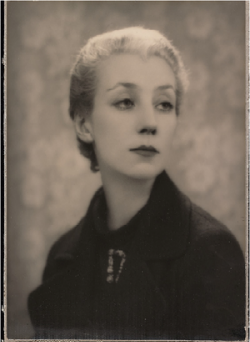

Queer Places:
Cimetière de Saint-Saphorin
Saint Saphorin, District de Lavaux-Oron, Vaud, Switzerland
 Isabelle Roussadana (Roussy) Mdivani
Sert (August 7, 1905 - December 16, 1938) was the daughter of Zakhari Mdivani and Elizabeta (Sabalewska).
Her siblings were: Nina (Mdivani) Harwood,
Serge Mdivani (married to
Pola Negri),
David Mdivani (married to
Virginia Sinclair) and
Alexis Mdivani. She married
Josep Maria Sert in 1928. When Sert
started a relationship with Roussy, his wife tried to accommodate herself to
the liaison her husband was having with another woman. She herself also
entered into a physical relationship with Roussy. For some time the three
sustained a ménage à trois. However, they ultimately divorced on 28 December
1927.
Isabelle Roussadana (Roussy) Mdivani
Sert (August 7, 1905 - December 16, 1938) was the daughter of Zakhari Mdivani and Elizabeta (Sabalewska).
Her siblings were: Nina (Mdivani) Harwood,
Serge Mdivani (married to
Pola Negri),
David Mdivani (married to
Virginia Sinclair) and
Alexis Mdivani. She married
Josep Maria Sert in 1928. When Sert
started a relationship with Roussy, his wife tried to accommodate herself to
the liaison her husband was having with another woman. She herself also
entered into a physical relationship with Roussy. For some time the three
sustained a ménage à trois. However, they ultimately divorced on 28 December
1927.
The Mdivani family was a Georgian noble family. The best known bearers of this name were the children of General Zakhari Mdivani and his wife Elizabeth. The five siblings fled to Paris after the Soviet invasion of Georgia, and became known as the "Marrying Mdivanis", as they all managed to marry into wealth and fame.
Isabelle Roussadana Mdivani, called Roussy, was a sculptor who wed Spanish painter Jose Maria Sert in 1928, succeeding the legendary Misia Sert as his wife, but died in 1938. It is said that Roussy, long before the existence of hippies, she dressed in hippie style, but a very elegant Chanel version of it—boots, shiny raincoats, boleros embroidered with colored stones, beanies tuck on the back of her head.
Isabelle Roussadana Mdivani grew up during the 1920s and was influenced by the artistic culture of the time. Important artistic developments that had been established in the earlier part of the 20th century continued to be matured during the 1920s and 1930s. During this period the careers of a number of influential and pioneering artists began to blossom, yet at the same time there was an atmosphere of consideration and sombreness following the horrors of the First World War. Major shifts in politics were happening worldwide, and Marxism took a strong hold as an ideology within artist groups and communities. Due to its cultural importance, Surrealism spread as an philosophy on an international scale, and became the most prominent theme of the pictorial arts in the 1920s. The Bauhaus movement developed during this time and focused on a unification of all modes of art, working towards the idea of the ‘Gesamtkunstwerk’. The liberal politics of the Weimar Republic in Germany enabled this movement to blossom and grow and develop further.
My published books: